
How to Use l293 motor driver: Examples, Pinouts, and Specs
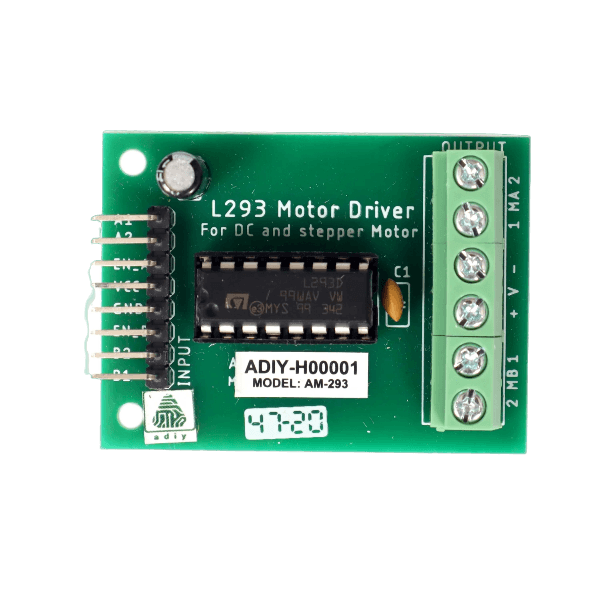
 Design with l293 motor driver in Cirkit Designer
Design with l293 motor driver in Cirkit DesignerIntroduction
The L293 motor driver is an integrated circuit (IC) designed to control the direction and speed of DC motors. It is widely used in robotics, automation projects, and various electronic applications where motor control is required. The L293 is capable of driving two motors simultaneously and is known for its ease of use and versatility.
Explore Projects Built with l293 motor driver
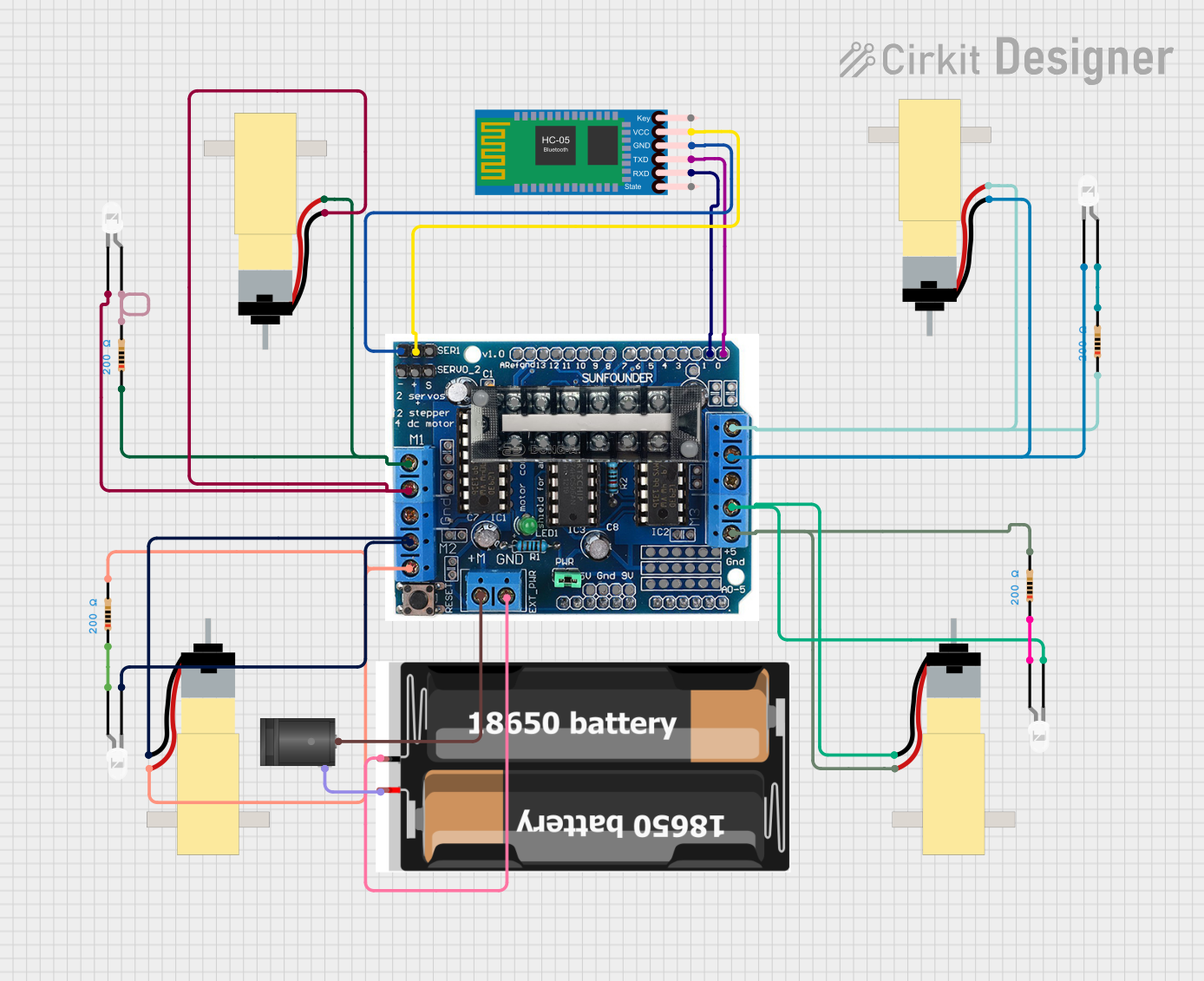
 Open Project in Cirkit Designer
Open Project in Cirkit Designer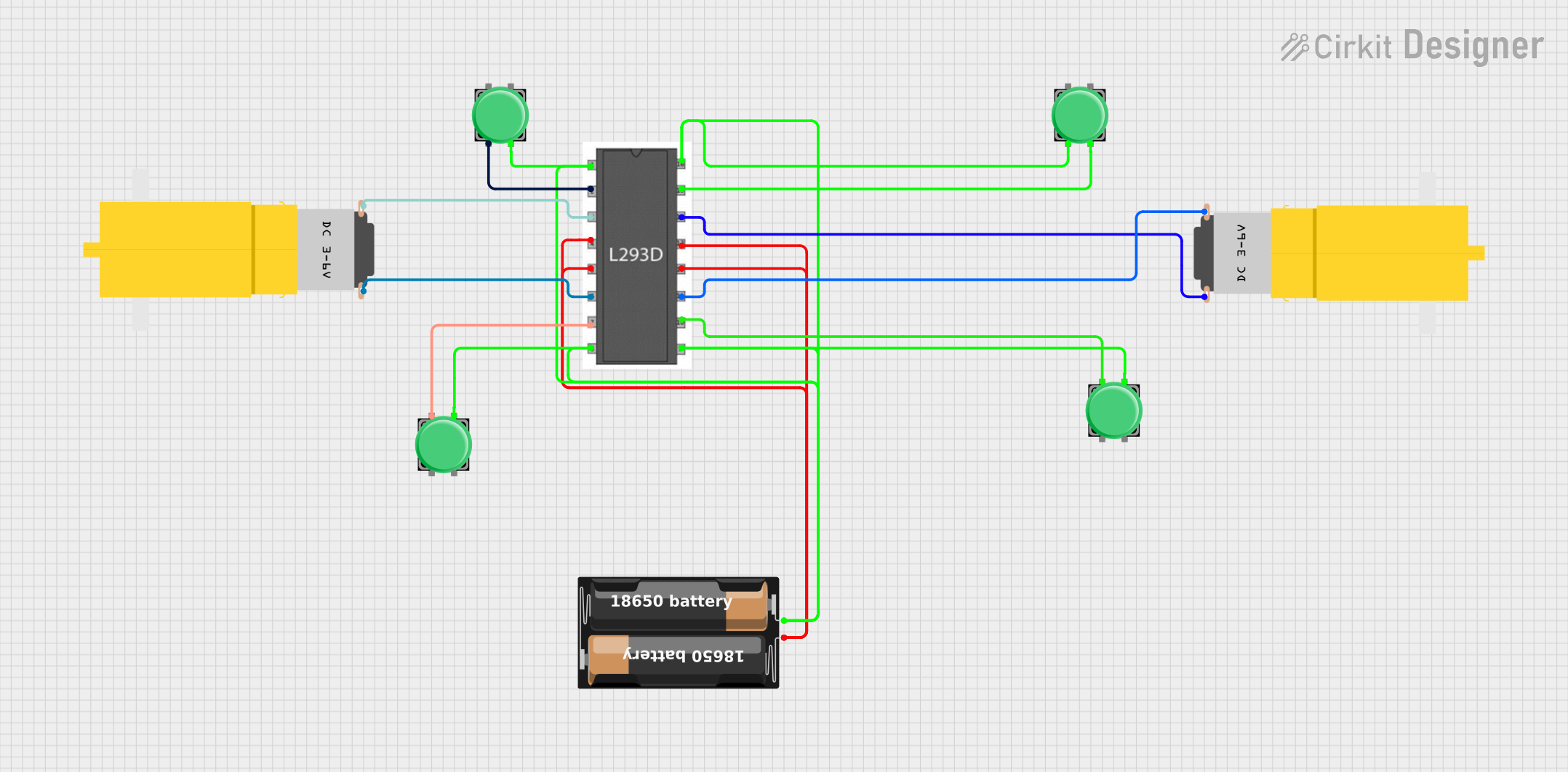
 Open Project in Cirkit Designer
Open Project in Cirkit Designer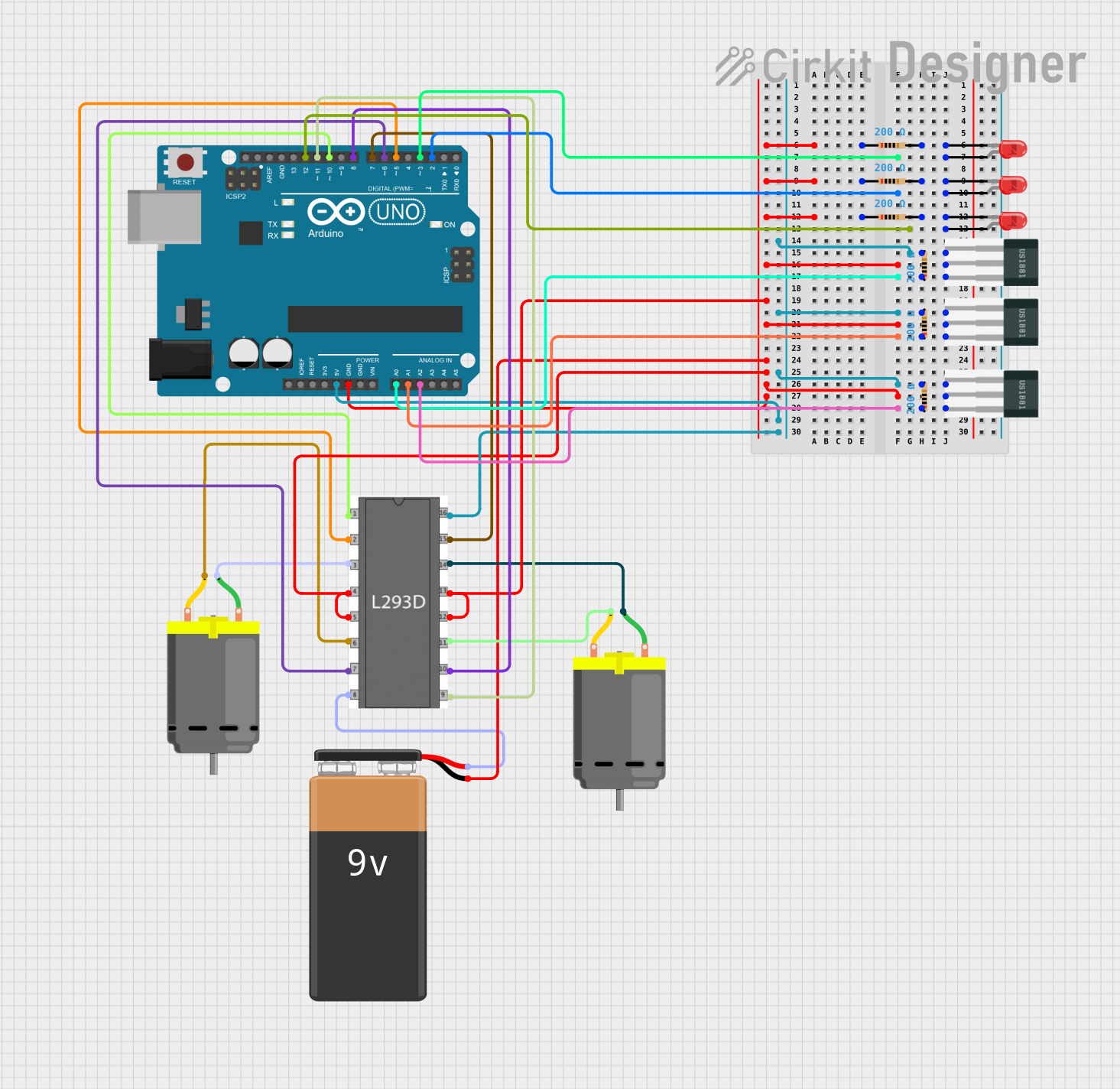
 Open Project in Cirkit Designer
Open Project in Cirkit Designer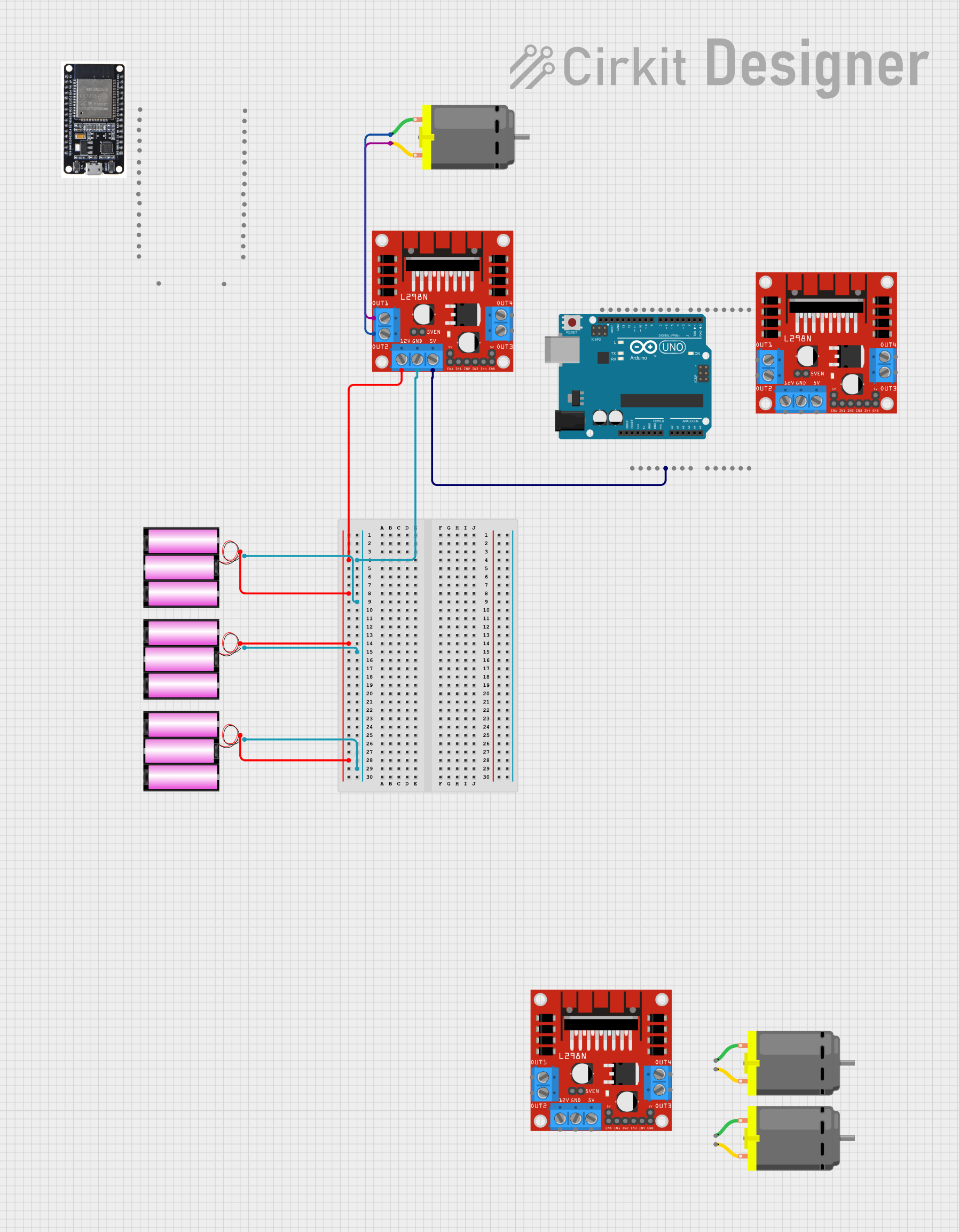
 Open Project in Cirkit Designer
Open Project in Cirkit DesignerExplore Projects Built with l293 motor driver

 Open Project in Cirkit Designer
Open Project in Cirkit Designer
 Open Project in Cirkit Designer
Open Project in Cirkit Designer
 Open Project in Cirkit Designer
Open Project in Cirkit Designer
 Open Project in Cirkit Designer
Open Project in Cirkit DesignerCommon Applications and Use Cases
- Robotics
- Automated machinery
- Hobbyist projects
- Educational platforms
Technical Specifications
Key Technical Details
- Supply Voltage (Vcc1): 4.5V to 36V
- Logic Supply Voltage (Vcc2): 4.5V to 7V
- Output Current (each channel): 600mA
- Peak Output Current (each channel): 1.2A
- Enable Input Voltage: 4.5V to 7V
Pin Configuration and Descriptions
| Pin Number | Name | Description |
|---|---|---|
| 1 | 1,2EN | Enable pin for Motor 1 and 2 |
| 2 | 1A | Input 1 for Motor 1 |
| 3 | 1Y | Output 1 for Motor 1 |
| 4 | GND | Ground (0V) |
| 5 | GND | Ground (0V) |
| 6 | 2Y | Output 2 for Motor 1 |
| 7 | 2A | Input 2 for Motor 1 |
| 8 | Vcc2 | Motor Supply Voltage |
| 9 | 3,4EN | Enable pin for Motor 2 and 3 |
| 10 | 3A | Input 1 for Motor 2 |
| 11 | 3Y | Output 1 for Motor 2 |
| 12 | GND | Ground (0V) |
| 13 | GND | Ground (0V) |
| 14 | 4Y | Output 2 for Motor 2 |
| 15 | 4A | Input 2 for Motor 2 |
| 16 | Vcc1 | Logic Supply Voltage |
Usage Instructions
How to Use the Component in a Circuit
- Connect Vcc1 to a 5V power supply for the logic part of the IC.
- Connect Vcc2 to a power supply suitable for your motor (up to 36V).
- Connect the ground pins to the common ground of your system.
- Connect the enable pins (1,2EN and 3,4EN) to logic high to enable the motor outputs.
- Connect the input pins (1A, 2A for Motor 1 and 3A, 4A for Motor 2) to your control signals.
- Connect the output pins to the terminals of your DC motors.
Important Considerations and Best Practices
- Use a separate power supply for Vcc2 if the motor voltage is higher than the logic voltage.
- Place a decoupling capacitor close to the Vcc1 and Vcc2 pins to minimize voltage spikes.
- Ensure that the current and power ratings of the motors do not exceed the IC's specifications.
- Use heat sinks if operating near the peak current ratings to prevent overheating.
Example Code for Arduino UNO
// Define motor control pins
#define MOTOR1_PIN1 2
#define MOTOR1_PIN2 3
#define MOTOR2_PIN1 4
#define MOTOR2_PIN2 5
// Define enable pins
#define ENABLE_MOTOR1 9
#define ENABLE_MOTOR2 10
void setup() {
// Set motor control pins as outputs
pinMode(MOTOR1_PIN1, OUTPUT);
pinMode(MOTOR1_PIN2, OUTPUT);
pinMode(MOTOR2_PIN1, OUTPUT);
pinMode(MOTOR2_PIN2, OUTPUT);
// Set enable pins as outputs
pinMode(ENABLE_MOTOR1, OUTPUT);
pinMode(ENABLE_MOTOR2, OUTPUT);
// Enable the motors
digitalWrite(ENABLE_MOTOR1, HIGH);
digitalWrite(ENABLE_MOTOR2, HIGH);
}
void loop() {
// Motor 1 forward
digitalWrite(MOTOR1_PIN1, HIGH);
digitalWrite(MOTOR1_PIN2, LOW);
// Motor 2 forward
digitalWrite(MOTOR2_PIN1, HIGH);
digitalWrite(MOTOR2_PIN2, LOW);
delay(2000); // Run motors for 2 seconds
// Stop motors
digitalWrite(MOTOR1_PIN1, LOW);
digitalWrite(MOTOR1_PIN2, LOW);
digitalWrite(MOTOR2_PIN1, LOW);
digitalWrite(MOTOR2_PIN2, LOW);
delay(1000); // Wait for 1 second
}
Troubleshooting and FAQs
Common Issues Users Might Face
- Motor not running: Check power supply, connections, and ensure enable pins are set high.
- Overheating: Ensure current through the motor driver does not exceed 600mA per channel or use a heat sink.
- Inconsistent motor speed or direction: Verify that the input signals are correct and stable.
Solutions and Tips for Troubleshooting
- Double-check wiring against the pin configuration table.
- Use a multimeter to verify the voltage at Vcc1, Vcc2, and the enable pins.
- Ensure that the logic signals are within the specified voltage range.
FAQs
Q: Can the L293 drive stepper motors? A: Yes, the L293 can be used to drive bipolar stepper motors with proper control signals.
Q: What is the maximum voltage that can be applied to Vcc2? A: The maximum voltage for Vcc2 is 36V.
Q: Can I control the speed of the motors using the L293? A: Yes, you can control the speed by applying PWM signals to the enable pins.
Q: Is it necessary to use external diodes with the L293? A: The L293 has built-in flyback diodes, but external diodes may be used for added protection.
This documentation provides a comprehensive guide to using the L293 motor driver. For further information, consult the manufacturer's datasheet.